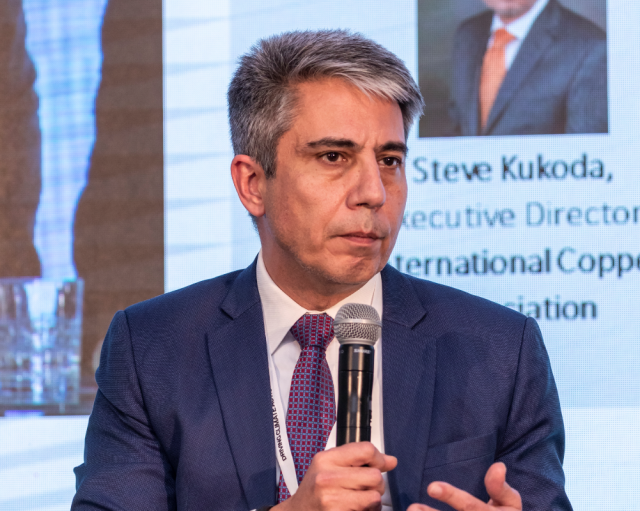Steve Kukoda on the importance of copper in helping to meet global climate emissions targets
Ahead of the Sustainable Innovation Forum 2020 taking place across 5 days from the 16-20 November, we caught up with Steve Kukoda, Executive Director at the International Copper Association, to discuss how copper can help to meet global climate emissions targets.

Ahead of the Sustainable Innovation Forum 2020 taking place across 5 days from the 16-20 November, we caught up with Steve Kukoda, Executive Director at the International Copper Association, to discuss how copper can help to meet global climate emissions targets.
2020 was meant to user in a decade of action on climate change but we have been fighting a different challenge, COVID-19. How do you think this has this impacted climate ambition and momentum?
Early on in the pandemic, the pandemic itself was the only thing being discussed in all forums, and climate was put on the backburner. As the pandemic slowed industry down, this resulted in a short-term reduction in emissions. Ongoing travel restrictions are continuing to limit emissions in some sectors.
As adjustments have been made to the “new normal,” climate has moved back in the spotlight with many stimulus efforts focused on strong, green components.
To meet 2030 targets, any decision, investments and industry we support will ultimately decide the future we rebuild. What is the role fo copper in building back the global economy?
Copper has unique and amazing natural properties: it is the best nonprecious conductor, it is antimicrobial, it is infinitely recyclable. Because of copper's widespread applications in most sectors of the economy — from homes and factories to electronics and power generation and transmission —copper is critical to building back the global economy. As an example, there are more than 120 possibe uses of copper in green and healthy buildings.
Can you tell our readers how you view copper in helping to meet global climate emissions targets?
There is perhaps no other metal or material more closely linked to the global SD agenda than is copper. Through the International Copper Association, the copper industry develops programs around the world that are making positive, tangible contributions to the UN SDGs. An audit of ICA’s programs shows some level of impact on all 17 SDGs. Of course, we are stronger in some areas, and in particular on SDG7 (clean and affordable energy) and SDG13 (climate action). ICA is one of the world’s most active industrial trade associations in this space and we build partnerships to accelerate the clean energy transition and climate action. A great example is United For Efficiency (U4E).
The pandemic has caused huge disruption to multiple supply chains and investment strategies. How can it be ensured that there is an efficient, sustainable and stable supply of copper?
According to the US Geological Survey, currently global copper reserves are estimated at 830 million tonnes and annual copper demand is about 28 million tonnes. Furthermore, according to USGS data, since 1950 there has always been, on average, 40 years of copper reserves available and over 200 years of resources, which include reserves, discovered and potentially profitable deposits and undiscovered deposits predicted based on preliminary geological surveys. These copper resources total 5,000 million tonnes (USGS, 2014 & 2017) In addition to the known reserves, it is worth noting that 35 percent of demand is met with recycled copper, significantly reducing the need for mined copper.
Recycling and the circular economy must be considered when talking about meeting future copper demand. By its nature, copper is a circular material as it does not lose quality when it is reused for another function. Not only will recycling more copper help to meet demand, but it will also make the industry even more sustainable and conserve more of the planet’s natural resources.
To learn more, click here.
The Three Percent Club is an exciting alliance that aims to put the world on a path to three percent annual efficiency improvement. Can you tell our readers some more about it and the role copper has to play in achieving this goal?
First it is important to understand why three percent. According to the International Energy Agency, the largest share of action (more than 40%) to meet the Paris climate change agreement needs to come from energy efficiency. This requires a global annual rate of improvement in energy efficiency of three percent. Sadly, this number has been less than half of where it needs to be in recent years. ICA is proud to be a founding member of the Three Percent Club, which brings together the leading institutions and organizations committed to accelerating the uptake of energy efficiency.
ICA’s flagship program in this space is United For Efficiency (U4E). This initiative is focused on transforming markets for appliances, industrial equipment and lighting toward energy-efficient technologies and policies. The co-founders of U4E are ICA and the UN Environment Program.
This year governments must submit their updated NDCs (Nationally Determined Contributions). What are your thoughts on the role of energy efficiency in them and why is this so important?
In many NDCs, energy efficiency is either mentioned in vague terms or not at all. This has to change – and quickly. Without strong and meaningful commitments to energy efficiency, it will not be possible to meet the Paris agreement. The Three Percent Club brings together the organizations and partnerships that can help countries to not only strengthen their commitments to energy efficiency in their NDCs, but to also put in place the programs that will allow them to make significant, verifiable reductions in emissions.
Speaking of energy efficiency, what is the role of copper in energy efficiency?
As the best nonprecious conductor of heat and electricity, the products that contain copper tend to operate more efficiently than if an inferior conductive material was used. Around 70% of copper is used in energy-consuming products that benefit from copper’s efficiency. Over their lifetimes, we estimate that that one tonne of copper in these products and systems will emit between 100 and 7,500 fewer tonnes of CO2 than if less-efficient conductors are used.
As a material, copper is infinitely recyclable. Can you please tell our readers some more about this and how the industry is working to make copper more sustainable?
It is true that copper is infinitely recyclable, without the loss of any of its amazing properties. It is estimated that two-thirds of the copper produced since 1900 is still in productive use around the world. Today, about one-third of copper demand is met through recycling, and we see that number increasing over time as the world embraces a circular economy.
In 2020, The Copper Mark (www.coppermark.org) was launched, a credible assurance framework to demonstrate the copper industry’s responsible production practices and industry contribution to the United Nations SDGs.
Over 50% of the world's population lives in cities and this is set to grow to 70% by 2050. As cities and future mobility changes to support this, what role do you foresee copper playing?
The rise in urban populations will mean increased investments in the infrastructures to make these cities not only livable but sustainable. Material choices will be critical. Copper contributes to sustainable construction through architectural designs, building wire systems, renewable energies conversion and better use of energy-efficient systems (heating, cooling, lighting, control, IT equipment, etc.). Copper is one of the top material choices for structural reinforcements, roofing, plumbing, heating equipment and many other applications. And I’ve already talked about its recyclability.
As the transportation sector becomes more and more electrified, this too provides a strong opportunity for copper. An EV typically uses 4X more copper than a vehicle operating with an internal combustion engine. EV infrastructure (i.e., charging stations) requires copper to operate safely and at peak efficiency.
With just 12 months to COP26, what must be done, what key actions must we see and what would you demand from businesses and governments ahead of these crunch negotiations?
It is past time for countries and businesses to embrace and accelerate energy efficiency. For countries, that means getting specific in their NDCs. For businesses, that means making commitments to use less energy as a way to decarbonize. The good news is that the technologies exist today for everyone to reduce energy consumption significantly. And this can be done profitably. Energy efficiency is not a cost, it is an investment, and one that pays for itself over and over again. Partnerships like the Three Percent Club are standing by to help. Let’s get it done!
Steve Kukoda will be speaking at Day 2 of the Sustainable Innovation Forum 2020. Join him and other industry leading experts by registering for free today.






